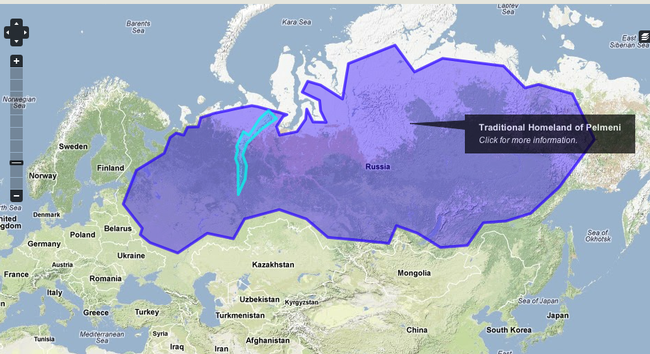The Finno-Ugric languages developed in the northern forest belt of western Siberia and northeastern Europe (Mason 250). In 1229, the Mongols, a Northern Chinese tribe, occupied the upper Urals. Soon after, one must assume that they proceeded to carry the concept of pelmeni to the rest of the Urals and Siberia as the dumplings took on different names as local cultures adopted them. Pelmeni gradually spread as far as Eastern Europe; Russians are said to have taken the habit of pasta directly from the East during this 13th to 15th century Mongolian occupation (Chamberlain 228). Because of this, pelmeni are said to potentially be of Asian derivation (Chamberlain 228). Other evidence that points to this is the vast migration of Asians from Central Asia via the Ural Mountain region sometime after 7000 B.C.E (Mason 250). While the word for these small dumplings comes from Finno-Ugric, their shape and fillings resemble Central Asian dumplings (Molokhovets 18). Pelmeni are similar to Mongolian buuz, Chinese jiaozi and Cantonese won ton because their fillings contain meat and they are made using thin dough (“Pelmeni”). Also, jiaozi and wontons are often served with vinegar, just like pelmeni. These similaries also make it probable that the dumplings native to Asia have the same origin as pelmeni. One theory even suggests that pelmeni originated in China because of the presence of black pepper in the filling. While pepper originally comes from India, China was involved in the spice trade and therefore potentially received pepper from India during the 7th Century.
Towards the end of the last century, pelmeni are said to have become famous in Russia because of the Lopachov Restaurant in Moscow (Culinaria 133). This old establishment housed one of the best pelmeni chefs from Siberia. Rumor has it that the owners of an important goldmine in Siberia entered the restaurant and ate almost nothing but pelmeni. Moreover, just 12 men consumed 2,500 of the morsels (Culinaria 133). Today, major cities such as Moscow and St. Petersburg have restaurants devoted to pelmeni called pel’mennye (Chamberlain 227).

